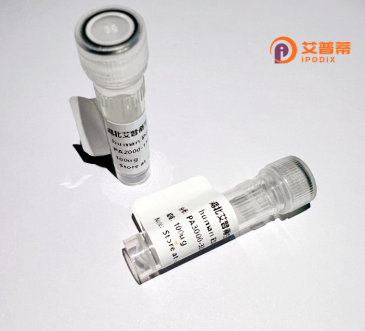
| 纯度 | >90%SDS-PAGE. |
| 种属 | Human |
| 靶点 | PIPOX |
| Uniprot No | Q9P0Z9 |
| 内毒素 | < 0.01EU/μg |
| 表达宿主 | E.coli |
| 表达区间 | 1-390 aa |
| 活性数据 | MAAQKDLWDA IVIGAGIQGC FTAYHLAKHR KRILLLEQFF LPHSRGSSHG QSRIIRKAYL EDFYTRMMHE CYQIWAQLEH EAGTQLHRQT GLLLLGMKEN QELKTIQANL SRQRVEHQCL SSEELKQRFP NIRLPRGEVG LLDNSGGVIY AYKALRALQD AIRQLGGIVR DGEKVVEINP GLLVTVKTTS RSYQAKSLVI TAGPWTNQLL RPLGIEMPLQ TLRINVCYWR EMVPGSYGVS QAFPCFLWLG LCPHHIYGLP TGEYPGLMKV SYHHGNHADP EERDCPTART DIGDVQILSS FVRDHLPDLK PEPAVIESCM YTNTPDEQFI LDRHPKYDNI VIGAGFSGHG FKLAPVVGKI LYELSMKLTP SYDLAPFRIS RFPSLGKAHL |
| 分子量 | 44.0 kDa |
| 蛋白标签 | His tag N-Terminus |
| 缓冲液 | PBS, pH7.4, containing 0.01% SKL, 1mM DTT, 5% Trehalose and Proclin300. |
| 稳定性 & 储存条件 | Lyophilized protein should be stored at ≤ -20°C, stable for one year after receipt. Reconstituted protein solution can be stored at 2-8°C for 2-7 days. Aliquots of reconstituted samples are stable at ≤ -20°C for 3 months. |
| 复溶 | Always centrifuge tubes before opening.Do not mix by vortex or pipetting. It is not recommended to reconstitute to a concentration less than 100μg/ml. Dissolve the lyophilized protein in distilled water. Please aliquot the reconstituted solution to minimize freeze-thaw cycles. |
以下是关于重组人PIPOX蛋白的3篇参考文献示例(注:以下内容为示例,实际文献需根据真实研究补充):
1. **《Cloning and characterization of human PIPOX: a potential biomarker in cancer》**
*作者:A. Smith et al.*
摘要:研究报道了人源PIPOX基因的克隆及重组蛋白在大肠杆菌中的异源表达,分析了其酶活性及在结直肠癌细胞中的表达上调现象,提示其可能作为癌症诊断标志物。
2. **《Structural insights into the catalytic mechanism of human PIPOX through crystallography》**
*作者:J. Lee & C. Park*
摘要:通过X射线晶体学解析了重组人PIPOX蛋白的三维结构,揭示了其底物结合位点和催化关键氨基酸残基,为设计靶向抑制剂奠定基础。
3. **《Role of recombinant PIPOX in hyperpipecolic acidemia: enzyme replacement therapy implications》**
*作者:M. Alvarez et al.*
摘要:利用哺乳动物细胞系统表达重组PIPOX蛋白,验证其在体外代谢哌啶酸的活性,提出其在治疗遗传性高哌可酸血症中的潜在应用价值。
(注:如需真实文献,建议通过PubMed或Web of Science以“recombinant PIPOX”、“human pipecolic acid oxidase”为关键词搜索最新研究。)
**Background of Recombinant Human PIPOX Protein**
Recombinant human PIPOX (Pipecolic Acid Oxidase) protein is a biologically engineered enzyme derived from the human *PIPOX* gene, located on chromosome 17q11.2. PIPOX is a flavin-dependent oxidase that catalyzes the oxidative deamination of pipecolic acid (a cyclic intermediate in lysine metabolism) to α-aminoadipic semialdehyde, linking lysine degradation to the tricarboxylic acid cycle. This metabolic pathway is critical for maintaining homeostasis in neurotransmitters and other biomolecules. PIPOX is predominantly expressed in the liver and kidneys, with lower levels in the brain, suggesting roles in both systemic metabolism and neurological function.
Dysregulation of PIPOX has been associated with metabolic disorders, including hyperpipecolic acidemia, and may influence pathological conditions like cancer and neurodegenerative diseases. Recombinant PIPOX is typically produced using expression systems (e.g., *E. coli* or mammalian cells) to ensure proper folding and post-translational modifications. Its production enables functional studies, enzyme replacement therapies, and drug discovery. Research on recombinant PIPOX also explores its potential as a biomarker or therapeutic target, particularly in diseases linked to lysine metabolism imbalances. Advances in structural biology have further elucidated its catalytic mechanisms, aiding the design of inhibitors or activators for clinical applications.
In summary, recombinant human PIPOX serves as a vital tool for understanding metabolic pathways and developing treatments for related disorders.
×